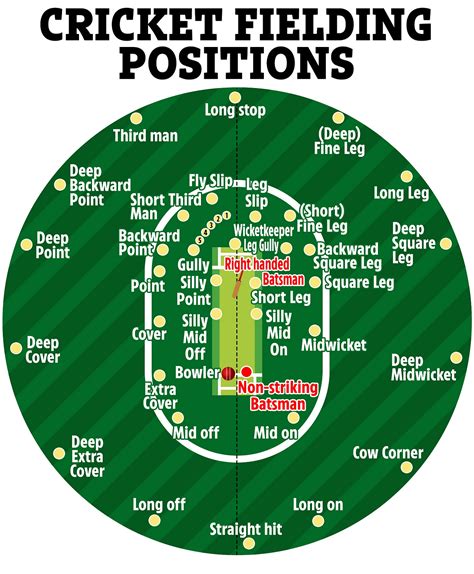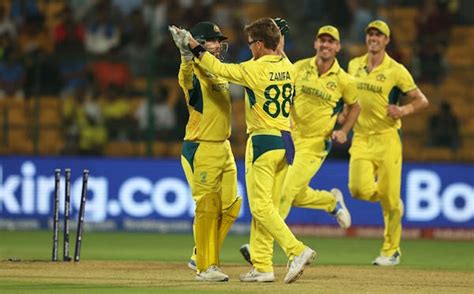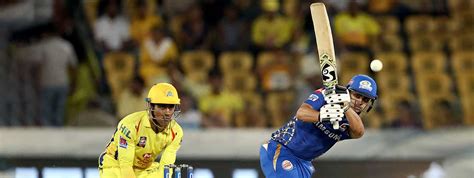Explore key cricket field positions, their strategic importance, and how effective placement maximizes team performance and game outcomes in this comprehensive guide.Cricket is not just a game of bat and ball; it’s a strategic battle that unfolds on the lush green landscape of the pitch. Understanding cricket field positions is crucial for both players and fans alike, as each position holds its unique significance and impact on the game’s outcome. From the tireless wicketkeeper to the vigilant slip cordon, every player has a distinct role that contributes to the team’s performance. In this article, we’ll explore the various fielding positions, their importance in shaping cricket strategies, and how effective field placements can turn the tide in crucial matches. Whether you’re a budding cricketer or an avid follower of the game, gaining insights into field positions will enhance your appreciation of cricket’s intricate strategies and elevate your understanding of this beloved sport.
Understanding The Key Positions On A Cricket Field
In cricket, the arrangement of players on the field is crucial for both offensive and defensive strategies. Each player has a designated role that aligns with the overall game plan, and understanding these cricket field positions is essential for players and fans alike.
Here are some key positions commonly found on a cricket field:
- Wicketkeeper: Positioned behind the stumps, the wicketkeeper plays a vital role in catching balls that pass the batsman and executing stumpings or run-outs.
- Slip Fielders: Positioned next to the wicketkeeper, these players are strategic targets for catching balls that edge off the bat.
- Mid-On and Mid-Off: Located in front of the bowler, these fielders help guard against boundary runs and provide support for various bowling strategies.
- Point and Cover: Situated on the off side, these players are crucial for stopping quick singles and fielding balls driven by the batsman.
- Square Leg: Positioned behind the batsman, this fielder protects against leg-side shots and helps in fielding pull and hook shots.
- Fine Leg: Positioned on the boundary, this player is responsible for catching or stopping runs from leg-side boundaries.
- Third Man: Positioned behind point, this player is critical for fielding edges from the batsman, especially in fast bowling.
The effectiveness of a team often hinges on how well these cricket field positions are utilized. Proper field placements can create pressure on the batting side, force mistakes, and capitalize on the weaknesses of the opposing players. Each position has its significance and can be adjusted based on the match situation, pitch conditions, and opposition’s batting strengths.
The Importance Of Field Placement In Cricket Strategy
Effective field placement is a critical aspect of cricket strategy that can greatly influence the outcome of a match. The way a team sets its field can either support its bowling efforts or hinder them, making it essential for captains and coaches to understand the significance of *cricket field* positions.
One of the primary advantages of strategic field placement is the ability to apply pressure on the batting side. By positioning fielders in areas where the batsman is likely to hit the ball, the team can create opportunities for catching or run-outs. For instance, having a close-in fielder at short leg or silly point is designed to intercept quick shots, which can lead to quick dismissals.
Moreover, field placement can be adjusted based on the playing conditions and the strengths and weaknesses of individual batsmen. For instance, if a particular batsman struggles against spin bowling, placing fielders in catching positions around the wicket can capitalize on this weakness. Similarly, if a bowler consistently bowls in a specific line or length, the captain can alter the field to support that strategy, enhancing the chances of taking wickets.
Another key aspect of field placement in *cricket field* strategy is to minimize the scoring opportunities for the batting team. By placing fielders in positions that cut off boundaries and quick singles, the bowling team can restrict the flow of runs and maintain pressure on the batsmen. This is particularly significant in limited-overs formats where scoring rates can escalate quickly.
The art of field placement serves as a dynamic tool for the bowling side. It requires constant assessment and adjustment based on game flow, batsman behavior, and opposition tactics, making it a cornerstone of a successful cricket strategy.
How Fielding Positions Affect Game Outcomes
Fielding positions are crucial in cricket as they directly influence not only the flow of the game but also the final outcome of a match. The placement of fielders is a strategic decision that can capitalize on opposition weaknesses while protecting against potential scoring opportunities.
When a team adopts effective cricket field placements, it can apply pressure on the batting side, often forcing them into making unforced errors. For example, placing fielders in catching positions close to the batsman can lead to early wickets if the batsman becomes aggressive and misjudges a delivery.
Moreover, the configuration of the cricket field can impact the bowler’s strategy. Different field placements allow bowlers to target specific areas of the pitch, encouraging batters to score in certain locations while increasing the risks of dismissals in others. A well-set field can support the bowler in executing plans against certain batsmen, thus enhancing the likelihood of successful outcomes.
In limited-overs formats, where boundaries are essential for scoring, setting attacking fields can help restrict the run rate. Conversely, in test matches, a defensive setup may be employed to draw out a batsman, creating opportunities for breakthroughs without necessarily conceding runs.
Fielding positions also dictate how effectively a team can respond to quick singles or boundaries. Well-placed fielders can cut off runs and create pressure, making it difficult for the batting team to settle in. This dynamic is vital in high-stakes matches where every run counts.
The way a team organizes its cricket field positions has significant ramifications on overall performance. Thoughtful placement can lead to tighter bowling, sharper fielding, and ultimately, greater chances of winning. As such, understanding the interplay between fielding positions and game outcomes is essential for anyone looking to deepen their appreciation of cricket strategy.
Key Roles Of Players In A Cricket Field Setup
In cricket, the field positions are crucial for orchestrating an effective gameplay strategy. Each player occupies a specific role that contributes to the team’s overall performance. Understanding these roles within the cricket field setup is essential for capitalizing on the strengths of individual players and addressing the weaknesses of opposing teams.
Here are the key roles of players in a cricket field setup:
- Bowler: The bowler’s primary responsibility is to dismiss batters through various delivery styles. Their role demands strategic positioning to capitalize on the fielders’ placements and create wicket-taking opportunities.
- Wicketkeeper: Positioned behind the stumps, the wicketkeeper plays a vital role in stopping runs, catching, and stumping batters. They must have good communication with bowlers and fielders to ensure proper field placement.
- Slip Fielders: Typically arranged behind the batsman, slip fielders are crucial for catching edge balls. Their positioning requires excellent reflexes and anticipation to secure quick dismissals.
- Point and Cover: Positioned near the infield, these players are instrumental in stopping runs on square and cover drives. Their agility and quick throw can apply pressure on batsmen attempting to take singles.
- Mid-On and Mid-Off: These positions are critical for supporting fast bowlers. They catch thick inside edges or provide backup for fielding against aggressive shots played straight down the ground.
- Deep Fielders: Players positioned at the boundary (such as deep square leg, deep cover, and long on) are tasked with saving boundaries and taking catches on lofted shots. Their placement is crucial in limiting the scoring options for the batsmen.
Effective communication and understanding among players are essential for maximizing the potential of the cricket field setup. By leveraging the specialized roles, teams can systematically impose pressure on their opponents, thus significantly influencing the game’s outcome.
Maximizing Team Performance Through Effective Cricket Field Positions
To maximize team performance in cricket, one of the crucial aspects is to optimize the Cricket Field placements according to the game situation, pitch conditions, and the individual strengths and weaknesses of both the bowlers and batsmen. Effective field positioning can lead to increased wicket-taking opportunities, reduced runs, and enhanced overall team morale.
Strategic decisions regarding the Cricket Field setup can drastically influence the match’s outcome. This includes placing fielders in positions that cover the most likely scoring areas, creating pressure on the batting side, and encouraging mistakes. Here are some key strategies to consider:
- Analyze the Batting Lineup: Understanding the specific tendencies of the opposition’s batting lineup is essential. Placing fielders in positions that counter the strengths of prominent batsmen can help restrict runs scored.
- Adjust for Pitch Conditions: Different pitches yield varying levels of bounce and spin. Adjusting field positions in relation to these conditions can capitalize on favorable bowling scenarios.
- Incorporate Bowler Strengths: Certain bowlers excel at bowling to particular fields. By aligning field placements that suit the bowler, teams can enhance their wicket-taking chances.
- Communicate Effectively: Consistent communication among players regarding Cricket Field positions is vital to avoid confusion during play and ensure everyone is aware of their roles.
- Adapt on the Fly: Flexibility is crucial; effective teams can quickly adjust their fielding positions based on the game’s ebb and flow, responding to breakthroughs or shifting momentum.
By focusing on these strategies, teams can take full advantage of the Cricket Field setup to enhance their performance, ultimately leading to better results in matches. The synergy between players, effective communication, and thoughtful field placements can indeed make a significant difference in a team’s success.
Frequently Asked Questions
What are cricket field positions?
Cricket field positions refer to the specific spots on the cricket field where players are positioned during a match to optimize defense and strategize against the opposing team.
Why is the positioning of fielders important in cricket?
The positioning of fielders is crucial because it can affect the outcome of each delivery, minimize runs, and maximize the chances of catching the ball or getting a batsman out.
What is the role of a slip fielder?
A slip fielder is positioned next to the wicketkeeper, often behind the batsman, to catch any edges off the bat, particularly during fast bowling.
How does the captain decide field placements?
The captain decides field placements based on the strengths and weaknesses of the batsman, the pitch conditions, the bowler’s skill set, and the match situation.
What is the significance of having a gully position?
The gully position is designed to catch balls that have been edged off the bat but miss the slips; it’s particularly effective against fast bowlers.
Can field positions be changed during a match?
Yes, field positions can be changed during a match depending on the context of the game, such as the specific batsman’s style or the state of the match.
What are some common fielding positions in cricket?
Some common fielding positions include slip, gully, point, cover, mid-off, mid-on, square leg, and fine leg, each having its specific role during play.









